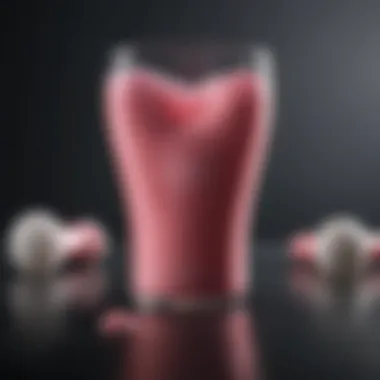Tampons vs. Pads: Deciphering the Best Menstrual Health Choice


Fashion Trends & Style Guides
Menstruation is a natural process experienced by women of various ages, yet the choice between tampons and pads remains crucial for menstrual health. Let's delve deep into the comparison to guide you in making an informed decision based on your unique preferences and needs. Understanding the differences in absorbency, comfort, sustainability, and convenience is essential for choosing the right menstrual product.
When considering menstrual hygiene products, absorbency plays a vital role in determining their effectiveness. Tampons offer a discreet and high-absorbency option, making them favored by women with an active lifestyle or those seeking to minimize visible signs of menstruation. On the other hand, pads provide reliable protection and are preferred by women who prioritize comfort and ease of use during their periods.
Moreover, sustainability is a growing concern in the realm of menstrual products. Exploring the environmental impact of tampons and pads is crucial as we strive towards a more eco-conscious lifestyle. While tampons are typically more compact and produce less waste, reusable pads emerge as a sustainable alternative, promoting a greener approach to menstrual care.
Lastly, convenience plays a significant role in decision-making when it comes to menstrual health. The ease of use and disposal of tampons and pads can influence your daily routines and overall comfort during menstruation. Considering factors such as portability, changing frequency, and disposal methods can help you choose the most convenient option for your lifestyle.
Introduction
Menstrual health is a crucial aspect of every woman's life, and the choice between using tampons and pads plays a significant role in maintaining hygiene and comfort during menstruation. Understanding the differences between these two menstrual products is essential for making an informed decision that aligns with individual needs and preferences. This article delves deep into the comparison between tampons and pads, dissecting the advantages, disadvantages, and considerations associated with each option to empower women with the knowledge necessary for optimal menstrual health.
Understanding Menstrual Products
When it comes to menstrual products, tampons and pads stand out as the primary choices for managing menstrual flow. Tampons, typically made of cotton, are inserted into the vagina to absorb menstrual blood directly from the source. On the other hand, pads, also known as sanitary napkins, are worn externally and collect menstrual blood as it leaves the body. Understanding how each product functions and the best practices for usage are crucial for ensuring menstrual health and hygiene.
Significance of Choosing the Right Product
Selecting the appropriate menstrual product is more than just a matter of personal preference; it directly impacts an individual's comfort, hygiene, and overall well-being during menstruation. Choosing the right product involves considering factors like absorbency levels, comfort, breathability, and potential health risks. The significance of this decision lies in its ability to enhance the overall menstrual experience, reduce the risk of infection or irritation, and promote a sense of confidence and ease during the menstrual cycle. Making an informed choice based on individual needs and requirements is key to maintaining optimal menstrual health.
Absorbency and Comfort
In this section, we delve into the crucial aspects of absorbency and comfort when contemplating the choice between tampons and pads for menstrual health. Absorbency plays a pivotal role in ensuring that menstrual products effectively manage blood flow. Comfort, on the other hand, is indispensable for women seeking to navigate their daily activities unhindered by discomfort. The interplay between absorbency and comfort is essential for a seamless menstrual experience. When choosing between tampons and pads, understanding the differences in absorbency levels and comfort features is paramount for women to make an informed decision that aligns with their preferences and lifestyle needs.
Tampons: Advantages and Disadvantages


Different Absorbency Levels
A key consideration when exploring tampons is the range of absorbency levels available to cater to varying menstrual flows. The diverse absorbency levels offered by tampons empower women to select a product that best suits their individual needs. Whether experiencing a light or heavy flow, having access to tampons with different absorbency levels allows for tailored menstrual care. Understanding the implications of each absorbency level is crucial in ensuring comfort and efficiency during menstruation. While high absorbency tampons offer extended protection, lower absorbency options cater to lighter flows, providing versatility for different stages of the menstrual cycle.
Comfort and Freedom of Movement
Comfort and freedom of movement are inherent advantages of using tampons for menstrual care. Tampons are discreet and do not hinder mobility, enabling women to engage in various physical activities with ease and confidence. The compact nature of tampons ensures a comfortable fit without impeding movement, offering a sense of liberation during menstruation. Additionally, tampons provide a higher level of discretion compared to pads, allowing women to navigate their daily routines without feeling encumbered by their menstrual product choice.
Pads: Pros and Cons
Breathability and Comfort
Pads are lauded for their breathability and comfort, making them a preferred choice for women seeking maximum airflow and skin-friendly materials. The design of pads promotes air circulation, reducing the likelihood of moisture build-up and discomfort during wear. The breathability of pads contributes to maintaining vaginal health by minimizing the risk of irritation or bacterial growth. Comfort is paramount when selecting menstrual products, and pads excel in providing a cushioned, soft barrier against leaks while ensuring a gentle touch against the skin.
Absorbency Levels for Different Flows
Another crucial aspect of pads is their varied absorbency levels tailored to different menstrual flows. From light to heavy flows, pads offer a spectrum of absorptive capacities to accommodate diverse needs. Choosing the appropriate absorbency level for a particular flow intensity is essential in preventing leaks and ensuring long-lasting protection. By selecting pads with absorbency levels aligned with their menstrual flow, women can experience confidence and peace of mind throughout their cycle.
Safety and Health Considerations
In this comprehensive guide on Tampons vs. Pads, delving into Safety and Health Considerations is crucial for a well-informed choice regarding menstrual health. Understanding the potential risks and best practices associated with each menstrual product is vital for women of all ages. Considering aspects like toxic shock syndrome (TSS) risks, changing frequency, and hygiene tips plays a significant role in ensuring menstrual health and well-being.
Tampons: Potential Risks and Best Practices
Toxic Shock Syndrome (TSS) Risk
Exploring the specific aspect of Toxic Shock Syndrome (TSS) Risk sheds light on a critical consideration within menstrual health discussions. TSS is known for its association with high-absorbency tampons, making it a key concern for women using tampons during menstruation. Understanding the symptoms, risks, and preventive measures related to TSS is essential for users of tampons to prioritize their health.
Changing Frequency and Hygiene Tips


Addressing the importance of changing frequency and hygiene tips when using tampons highlights the need for regular changes to prevent infections and promote overall hygiene. Educating women on the appropriate time intervals for changing tampons and providing hygiene tips ensures a safe and comfortable menstrual experience. Emphasizing the significance of following best practices with tampon usage contributes to maintaining optimal menstrual health.
Pads: Health Implications and Usage Recommendations
Skin Irritation and Allergies
Examining the impact of skin irritation and allergies associated with pads brings attention to a common concern among pad users. Skin sensitivity and allergic reactions to certain pad materials can cause discomfort and affect menstrual health. Understanding the characteristics of skin irritation and allergies helps women make informed decisions when selecting pads that align with their skin type and preferences.
Proper Disposal Methods
Discussion on the importance of proper disposal methods for pads is essential in promoting hygiene and environmental sustainability. Highlighting the significance of disposing of pads responsibly to prevent health hazards and environmental pollution encourages users to adopt eco-friendly practices. Educating on proper disposal techniques ensures that women effectively manage menstrual waste while prioritizing health and hygiene.
Environmental Impact
As we delve into the comparison between tampons and pads for menstrual health, it is crucial to consider the significant aspect of environmental impact. The choices we make regarding menstrual products have a direct effect on sustainability and ecological well-being. Understanding the environmental consequences of our choices is paramount in today's world, where environmental awareness plays a pivotal role in decision-making processes. Sustainable practices in menstrual product usage can contribute to a healthier planet and a more eco-conscious lifestyle.
Tampons vs. Pads: Eco-Friendliness
Biodegradability and Sustainability
The concept of biodegradability and sustainability is a fundamental aspect when evaluating the eco-friendliness of menstrual products. Biodegradability refers to the ability of a product to decompose naturally without leaving harmful residues in the environment. Sustainability, on the other hand, focuses on the long-term impact of product use on the planet's health and resources. In the context of menstrual health, opting for products with biodegradable materials can significantly reduce waste and environmental harm. The key characteristic of biodegradability lies in its capacity to break down into natural elements, minimizing pollution and supporting ecosystem balance. Choosing biodegradable menstrual products aligns with the goals of this article, promoting eco-conscious decisions for a greener future.
Reducing Carbon Footprint
Reducing the carbon footprint associated with menstrual products is another vital consideration for eco-friendliness. The carbon footprint represents the total greenhouse gas emissions produced throughout the lifecycle of a product. By selecting menstrual products that prioritize carbon reduction strategies, individuals can lessen their impact on climate change. Emphasizing the importance of reducing carbon emissions in the manufacturing, distribution, and disposal of menstrual products can lead to a more sustainable approach to menstrual health. The unique feature of reducing the carbon footprint is its ability to mitigate climate change effects by minimizing carbon dioxide emissions. Incorporating information on carbon footprint reduction adds value to this article, highlighting the significance of environmentally friendly choices for menstrual health.
Cost-Effectiveness and Accessibility


Cost-effectiveness and accessibility play a pivotal role in the decision-making process when it comes to menstrual products. Understanding the financial implications and the ease of obtaining these products is crucial for women of all ages and backgrounds. By delving into the cost-effectiveness and accessibility aspect of tampons versus pads, individuals can make informed choices that align with their budgetary constraints and lifestyle demands.
Comparing Costs: Tampons and Pads
When it comes to comparing the costs of tampons and pads, the focus shifts towards long-term expenses and the availability and convenience of these products. Analyzing the financial impact of choosing between tampons and pads over an extended period sheds light on the economic feasibility of each option.
Long-Term Expenses
Long-term expenses are a significant consideration when evaluating the cost-effectiveness of menstrual products. Understanding how the upfront expenses and recurring costs of tampons and pads differ can influence decision-making. Exploring the longevity and value of each product in terms of absorption capacity and comfort is essential in determining which option aligns better with an individual's financial plan. The analysis of long-term expenses provides insights into the overall economic sustainability and practicality of using tampons or pads.
Availability and Convenience
Availability and convenience are key factors in the accessibility of menstrual products. Examining the ease of purchasing tampons and pads, whether in physical stores or online platforms, impacts the overall user experience. Considering factors such as product variety, sizes, and brands, along with the convenience of acquisition and disposal, aids in choosing the most accessible option. Evaluating the convenience of usage during different activities and settings also contributes to the decision-making process, ensuring that the chosen menstrual product aligns seamlessly with an individual's lifestyle and preferences.
Personal Preferences and Lifestyle Factors
In the vast realm of menstrual health, personal preferences and lifestyle factors play a pivotal role in determining the most suitable menstrual product for each individual. Understanding one's unique needs, routines, and activities is essential in making an informed choice between tampons and pads. Factors such as comfort, convenience, and practicality heavily influence this decision-making process. Women of all ages must consider their routines, habits, and personal comfort levels when selecting a menstrual product to ensure seamless and hassle-free menstruation experiences.
Choosing Based on Lifestyle Needs
Active Lifestyle vs. Sedentary Lifestyle
Embarking on a discussion about lifestyle factors, the dichotomy between an active lifestyle and a sedentary lifestyle emerges as a critical point of consideration. Active individuals, who engage in regular exercise or lead physically demanding lives, may find tampons more conducive due to their discreetness and freedom of movement. On the contrary, those with a sedentary lifestyle, characterized by prolonged periods of sitting or minimal physical activity, might opt for pads for their simplicity and comfort during more relaxed daily routines. Understanding the nuances of an active vs. sedentary lifestyle allows women to align their menstrual product choice with their daily activities, ensuring optimal comfort and functionality in managing menstrual flow.
Ease of Use and Discretion
Delving deeper into lifestyle considerations, the aspects of ease of use and discretion come to the forefront. The ease of use, referring to the convenience and simplicity of application, is a key consideration for women juggling busy schedules or preferences for straightforward menstrual care. On the other hand, discretion, denoting the ability to conceal or carry menstrual products inconspicuously, is essential for maintaining privacy and comfort in various settings. Evaluating the trade-offs between ease of use and discretion aids women in selecting a product that aligns with their lifestyle needs, whether prioritizing convenience or subtlety in managing menstrual health comfortably and confidently.
Conclusion
When it comes to the critical decision-making process between tampons and pads for menstrual health, it is imperative to carefully consider various factors to ensure the optimal choice for individual preferences and requirements. The significance of the conclusion section within the broader context of the article lies in its ability to sum up the essential points discussed throughout the various sections, offering readers a cohesive understanding of the comparative analysis between tampons and pads. By highlighting key elements such as absorbency levels, comfort, environmental impact, cost-effectiveness, and personal lifestyle considerations, the conclusion serves as a crucial tool in empowering women to make informed choices regarding their menstrual hygiene. It consolidates the insights presented in preceding sections, guiding readers towards selecting the most suitable menstrual product that aligns with their distinct needs and priorities.
Making the Right Choice for You
In the realm of menstrual health, choosing between tampons and pads necessitates a thoughtful evaluation of personal preferences and lifestyle considerations. Making the right choice for you involves a comprehensive analysis of factors such as absorbency requirements, comfort levels, environmental considerations, cost-effectiveness, and convenience. Active lifestyle individuals may lean towards tampons for their discreetness and freedom of movement, while those with sensitivities might opt for pads for their breathability and comfort. Striking a balance between effectiveness and comfort is crucial in selecting the ideal menstrual product that caters to individual needs. Ultimately, the decision-making process should prioritize user comfort, health considerations, and personal convenience to ensure a seamless experience during menstruation.







